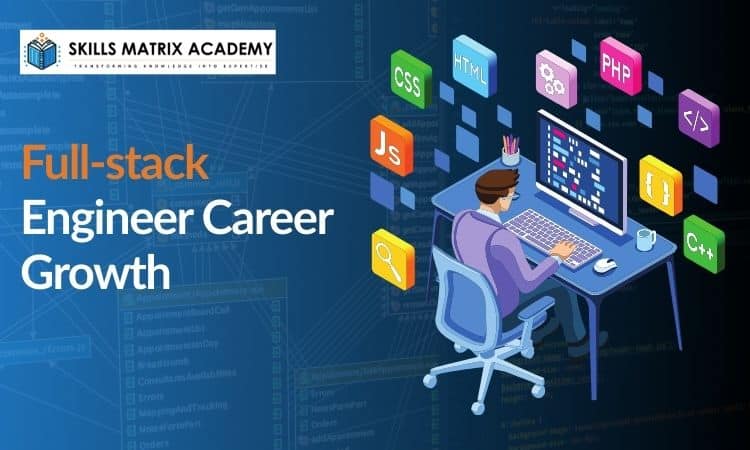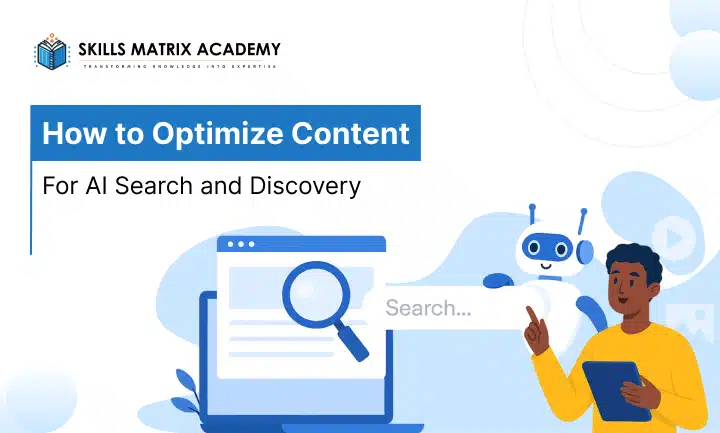Why a Career as a Full-Stack Engineer Is a Smart Choice
If you like technology, a career as a full-stack engineer can be rewarding. It is a strong career goal. Naukri lists thousands of full-stack jobs across India. Companies need people who can do both front-end and backend development.

A full-stack developer is responsible for developing both the user-facing side and the behind-the-scenes functionality of a project. They handle the user interface, server, code, and database. This makes full-stack development very important for web application development.
Definition of Full-Stack Engineer?
A full-stack engineer handles both the front-end and backend of a project, managing everything users see and the underlying systems that make it work. They manage everything, from the user interface that people see to the server and database that power the application.

A full-stack developer manages the full technology stack.They make sure both the visible parts (client-side) and the hidden parts (server-side) work smoothly together. By combining front-end coding, backend logic, and infrastructure, they build a complete application from start to finish.
Understanding the Stack
A stack is the collection of technologies that work together to build and operate applications. Together, they build and run web applications.
Most stacks use one programming language. For example, the MERN stack (MongoDB, Express, React, Node.js) enables a full-stack engineer to build apps from scratch, combining front-end and backend components efficiently.
What Education Do Full-Stack Developers Need?
Full-stack developers typically require a bachelor’s degree in web development or computer science. Higher education is likely to get you higher pay and job prospects.

Formal education is not mandatory. Employers value relevant knowledge and hands-on skills more than degrees. A full-stack development boot camp is a fast way to launch a full-stack developer career. Check boot camp rankings to find the top programs.
Some professionals first earn an associate or bachelor’s degree in a different field, then join a bootcamp to gain advanced development skills. Most coding bootcamps make entry simple, needing only a high school diploma or GED.
Continuing education is essential. Continuing learning of new programming languages and keeping on top of new technologies makes you competitive and ahead of others. Combining formal education, bootcamps, and ongoing learning ensures a strong career in full-stack development.
What Does a Full Stack Engineer Do?
A full-stack engineer works on many problems. They have end-to-end ownership of projects—from concept to deployment.

They handle both client-facing and server-side tasks. Full-stack engineers turn ideas into working software. They balance design, coding, testing, and deployment. Their work affects both end-users and backend systems, making this role an ideal career goal in tech.
Key Responsibilities
Full-stack engineers do many things every day:
- Gather project requirements from clients and stakeholders to follow the software product vision.
- Brainstorm and collaborate with the design team to develop innovative solutions that drive business growth and success—review design prototypes before coding.
- Handle problems in HTML, CSS, and JavaScript for smooth client-side performance. Use front-end frameworks.
- Make the web application responsive and accessible for all end-users.
- Manage and maintain databases and servers to ensure optimal client-side functionality.
- Keep applications secure, fast, and scalable.
Monitoring and Code Quality
Full-stack engineers check software and write tests. This makes sure the code works correctly. They fix bugs to keep the software optimized and running smoothly.
They write clean, efficient code. Following industry standards ensures that apps are easy to maintain and update. Full-stack engineers also learn new technologies to meet business needs.
Product Development
Building a Minimal Viable Product (MVP) is essential. It shows the app to stakeholders and gathers feedback from decision-makers.
After feedback, full-stack engineers add new features.his helps apps deliver a better experience for users and value for businesses. It also helps you reach your career goal as a skilled engineer.
Code Reviews and Documentation
Full-stack engineers review the code of other engineers. They give constructive feedback to improve quality.
They also write and read documentation of the software development process. This makes teamwork easier and future updates simpler.
Company Size Differences
Tasks of a full-stack engineer can change depending on company size:
- Small company: One full-stack engineer may handle everything, both front-end and backend.
- Large company: Separate front-end developers and backend developers work on specialized tasks. Teamwork keeps everything running smoothly.
How To Become A Software Engineer
Becoming a full-stack engineer takes time. You don’t have to know every tool and technology. Instead, focus on acquiring well-rounded knowledge of technology and having sufficient expertise to solve problems using code. Pursuing this path can be a strong career goal for anyone interested in the tech industry.

A full-stack web developer works on both front-end and backend development, making them essential for building complete web applications.
1.Learn Internet and Web Fundamentals
As a full-stack engineer, understanding the fundamentals of the Internet is crucial. Understand how the Internet functions while learning key web basics such as DNS and IP addresses.
You should also understand HTTP (HyperText Transfer Protocol). It manages communication between clients, such as web browsers, and servers. This knowledge helps you create dynamic web applications efficiently.
2.Learn Front-End Web Development Fundamentals
Three main pillars or core languages that drive front-end web development: HTML, CSS, and JavaScript
- HTML (HyperText Markup Language) defines the structure and content of a page, including text, links, forms, images, and videos.
- CSS (Cascading Style Sheets) styles the HTML content, controlling layout, design, and responsiveness on all screen sizes.
- JavaScript is the only programming language that runs directly in the browser. It creates interactive web pages and works alongside HTML and CSS.
- These skills are essential for creating user-friendly web applications and form the foundation for a full-stack engineer’s career goals.
3.Learn Git and GitHub
Git and GitHub are key tools in any software engineer’s workflow.
- Git is a version control system. It tracks changes, backs up projects, and allows you to revert to previous versions. It also enables project collaboration.
- GitHub is an online platform for Git repositories. It makes sharing code, reviewing work, and collaborating easier for development teams.
Learning Git and GitHub ensures smooth teamwork and organized development.
4.Learn a Front-End Library or Framework
Once you understand JavaScript, you can learn a front-end library or front-end framework.
- A front-end library provides reusable code, like functions, methods, or objects, to simplify development.
- Front-end frameworks simplify the process, allowing faster and more efficient web development.
Popular tools, such as React, enable full-stack engineers to create scalable and interactive web applications.
5.Learn Backend Web Development
Every full-stack engineer must have strong backend development skills.
Pick up any one language for server-side scripting, such as Python, Ruby, or Java. These manage the server, application logic, and database operations behind the scenes.
JavaScript can now be used on the back end as well, with Node.js, a JavaScript runtime designed to build dynamic and scalable web applications. This makes it easier to manage both client-side and server-side tasks in full-stack development.
6.Learn Database Management Systems and SQL
As a full-stack engineer, you will spend a lot of time working with databases. Most web applications use a database to store user data and other project information.
A database management system (DBMS) enables you to save, retrieve, update, and handle data in an efficient manner.
Two main types of databases are:
- Relational databases (SQL): Store data neatly in rows and columns for easy access.
- Non-relational or NoSQL databases: Store data in flexible formats without tables.
Knowing SQL and DBMS concepts is essential for building optimized, scalable web applications. Writing queries lets you fetch exactly the data you need for your projects.
Full-stack engineers and other software engineers usually earn comfortable and competitive salaries. Their expertise in both front-end and backend development makes them highly valuable in the technology job market.

According to the U.S. Bureau of Labor Statistics, the median annual salary for software engineers is $109,020. This gives a good benchmark for professionals starting a career in software engineering.
For full-stack engineers, the numbers are slightly higher. According to Glassdoor, the average annual salary for full-stack engineers is approximately $120,300, while Indeed reports an average salary of $120,749 per year. The Stack Overflow developer survey reveals an even higher figure, with the annual average wage for full-stack developers reaching $140,000. These numbers show the high demand and attractive compensation for skilled full-stack engineers in the USA.
However, compensation can vary based on several factors. Location plays a key role, as salaries for full-stack engineers in tech hubs tend to be higher than in smaller cities. Years of experience also significantly impact earnings, with senior engineers and those possessing advanced skills earning substantially more. Additionally, the company size, industry, and mastery of specific technology stacks can influence your full-stack engineer’s salary.
What Skills Does a Full-Stack Engineer Need?

If skills are the most important thing to get hired as a full-stack engineer, what should they be? A successful full-stack engineer needs both hard skills and soft skills to excel.
Hard Skills
Full-stack engineers are involved in both front-end and backend development, so you require skills in both. You also need to understand how software components communicate efficiently. Key hard skills include:
- Front-end programming languages: HTML, CSS, JavaScript
- Backend programming languages: Python, SQL, PHP
- Website architecture: Planning and designing the site structure
- Version control: Systems for tracking changes in code
- APIs: Tools that allow software communication between different parts of an application
With these skills, a full-stack engineer can create dynamic web apps and handle end-to-end development smoothly.
Soft Skills
Technical knowledge alone isn’t enough to succeed as a full-stack engineer. Strong soft skills are equally important.
- Patience and persistence: Code never works on the first attempt. You need to overcome coding difficulties.
- Attention to detail: Even a small mistake can break your program. Every detail matters.
- Curiosity and lifelong learning: Technology changes fast. A full-stack engineer must keep learning.
Besides coding, collaboration is critical. You’ll work with engineers, product managers, and designers to keep development smooth.
FAQ
Q1.How Long Does It Take to Become a Full-Stack Developer?
A. The time to become a full-stack developer depends on your career path. Many developers earn a four-year bachelor’s degree. Others take full-stack development bootcamps, which are faster and focus on practical skills.
Q2.What Is the Best Full-Stack Bootcamp?
A.Many coding bootcamps prepare you for full-stack developer jobs. The best one depends on your budget, location, and curriculum. Use guides and boot camp rankings to choose a program that aligns with your goals.
Q3.Can I Teach Myself to Be a Full-Stack Developer?
A.Yes! Some people self-learn full-stack development. You can gain skills through online courses, tutorials, and projects. Employers often accept portfolios showing your practical experience, even without formal training.
Q4.Can I Become a Full-Stack Developer With No Experience?
- A. Absolutely. Full-stack engineers can land jobs with no professional background, especially after training or bootcamps. You can improve your chances by doing internships, projects, or capstone assignments that showcase your abilities.










